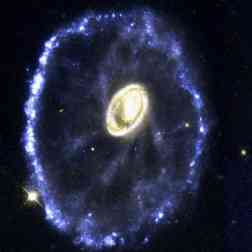
Space VLBI
Larger-than-Earth Telescopes
In Space VLBI, an Earth-orbiting radio telescope is connected to a network of ground-based telescopes. This allows the electronic inter-link to act as one telescope with a lens the size of the space craft's orbit.
According to one site http://sgra.jpl.nasa.gov
"The main science of Space VLBI focuses on the study of massive black holes. Radio galaxies and Quasars are thought to be the physical evidence of black holes.

Figure 1 One super-massive black hole.
A black hole is something so massive that its escape velocity is greater than the speed of light, so no light can escape from it. While no one has ever "seen" a black hole, we know that the space around a black hole is not actually black. Material is pulled toward a black hole by its strong gravity field. This forms a swirling "accretion" disk around a black hole and enormous amounts of energy are released as the material slowly spirals into it. Some of the material is shot out in radiating jets along the axis of rotation of the disk. These jets radiate in radio bands which are visible to radio telescopes. Prior to the understanding of their source of energy, they were labeled Quasars (quasi-stellar radio sources).

Figure 2 A black hole similar to SS-433, a mysterious object in the southern sky.
A key goal of Space VLBI is to use the long baselines between Earth and a spacecraft in orbit, and the precision of interferometry to allow us to create images as close as possible to the accretion disk around black holes, with as much detail as possible. Our resolution can be more than a thousand times better than even the best optical telescopes. "

Figure 3 Galactic conundrum - the Cartwheel Galaxy as seen using VLBI techniques.

Figure 4 The ungainly Egg-nebula

Figure 5 A horrendous space kablooie (lower left hand corner, white bright star) in the far far distant galaxy NGC4526. By the way the more conventional term for kablooie is "supernova."

Figure 6 Artists conception of the rather bizarre object, SS433.
As you can clearly see, VLBI is one useful technique.

